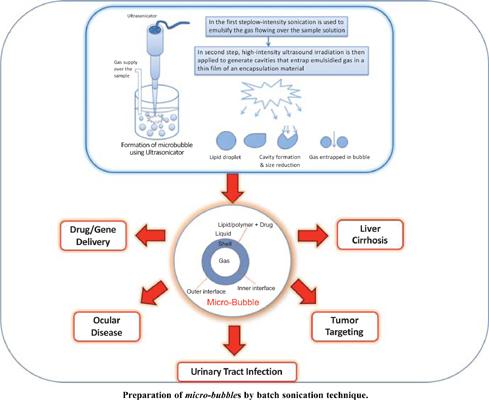Current Pharmaceutical Biotechnology ( IF 2.2 ) Pub Date : 2021-08-31 , DOI: 10.2174/1389201021999201109221102 Sandeep Rathor 1 , Sheikh Aamir 1 , Dinesh C Bhatt 1 , Krishan Kumar 2 , Vikash Kumar 3

|
Background: The general purpose of this review was to briefly describe the Gastro-Retentive Drug Delivery System (GRDDS) and to primarily focus on mechanisms of flotation for gastric retention.
Methods: The principle mechanism of Floating Drug Delivery Systems (FDDS) is mainly based on hydro-dynamically controlled low-density system, which gets swollen when comes in contact with the gastric environment and remains buoyant for an extended period of time with improved bioavailability and therapeutic efficacy. The main perspective of this review was to focus on microbubble drug delivery due to its wide range of applications.
Results: Microbubble is a new, economically viable, and non-invasive technique that is alternative to conventional techniques. The size of microbubbles ranges from 1-100 micrometers, which contain oxygen or air and remain suspended for prolonged drug release. Due to its great potential, microbubble is used in the therapeutic delivery of drug molecules or genetic material at their specific targeted site in various diseases. The recent research also suggests that ultrasound-mediated microbubble is more frequently used in the biomedical field for imaging of site-specific molecule targeting for the detection of disease and site-specific drug delivery.
Conclusion: Gastro-retentive floating drug delivery system was considered as the most favorable approach for site-specific drug delivery. But nowadays, microbubble is gaining more popularity for its potential applications in the biomedical field. In recent years, there is much progress in microbubble for site-specific delivery of a drug or genetic material. Recent research also suggests that the ultrasound- mediated microbubble has shown a positive impact on the diagnosis and clinical management of various diseases such as liver cirrhosis, brain tumor, ocular, and urinary tract infection.
中文翻译:

微泡概念、发展及其在治疗药物递送和疾病临床管理中的应用综述
背景:本综述的一般目的是简要描述胃滞留给药系统 (GRDDS),并主要关注胃滞留的漂浮机制。
方法:浮动药物递送系统(FDDS)的原理机制主要基于流体动力学控制的低密度系统,当与胃环境接触时会膨胀并长时间保持漂浮状态,提高生物利用度和治疗功效。由于其广泛的应用,本综述的主要观点是关注微泡药物递送。
结果:微泡是一种新的、经济可行的、非侵入性的技术,可以替代传统技术。微泡的大小范围为 1-100 微米,其中含有氧气或空气并保持悬浮状态以延长药物释放时间。由于其巨大的潜力,微泡被用于在各种疾病的特定靶点治疗药物分子或遗传物质的递送。最近的研究还表明,超声介导的微泡更常用于生物医学领域,用于位点特异性分子靶向成像,以检测疾病和位点特异性药物递送。
结论:胃滞留浮动给药系统被认为是最有利的部位特异性给药方法。但如今,微气泡因其在生物医学领域的潜在应用而越来越受欢迎。近年来,微泡在药物或遗传材料的位点特异性递送方面取得了很大进展。最近的研究还表明,超声介导的微泡对肝硬化、脑肿瘤、眼部和尿路感染等各种疾病的诊断和临床管理显示出积极的影响。











































 京公网安备 11010802027423号
京公网安备 11010802027423号